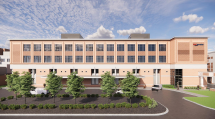“I love the people at the Joint Surgery Center. Going there is like coming home.”

Cheryl McCollum, 71, of Hillsborough thought she knew what to expect when she returned to Robert Wood Johnson University Hospital (RWJUH) Somerset for hip replacement surgery in 2022. She’d had surgery to replace her left hip in 2015, and it had gone so well that she became a volunteer at the hospital’s Joint Surgery Center.

When Cheryl’s right hip began to wear out and she felt the familiar pain of osteoarthritis, she made a new appointment. “She had a lot of pain in her hip and a pretty significant limp,” says Stephen Kayiaros, MD, an orthopedic surgeon and Medical Director of the joint surgery program at RWJUH Somerset, who specializes in minimally invasive joint replacement surgery.
This time, a different surgical approach to hip replacement was available, and Dr. Kayiaros thought Cheryl was a candidate for it.
A Muscle-Sparing Method
In any hip replacement, the surgeon swaps both the ball of bone at the top of the femur and the socket of the pelvic bone with prosthetic parts to relieve pain and improve movement. But the ways in which surgeons gain access to the hip joint can differ.
Cheryl’s first surgeon had taken a posterior approach to her left hip. With this commonly performed procedure, the surgeon accesses the joint from behind through an incision close to the buttocks. With the more recently developed anterior approach, the surgeon makes the incision toward the anterior, or front, of the hip area.
Both approaches have advantages and disadvantages. But with an appropriate patient and a skilled surgeon, the anterior approach entails less disruption of major walking muscles, which tend to heal slowly. As a result, the procedure is associated with less pain and faster recovery than the posterior approach.
“The anterior approach involves going in between muscles and not cutting or detaching them,” says Dr. Kayiaros. “Anytime you can do that, it’s going to make for a smoother patient experience.”
Cheryl could tell the difference right away. “I had much less pain post-op with this hip,” she says about her surgery last March. “And I had no restrictions on my movement. With the posterior approach, I couldn’t cross my legs at first. With the anterior method, I could do whatever I wanted.”
As predicted, her recovery was also easier. Previously, a physical therapist had visited her at home the first week post-op, and Cheryl had followed up with additional therapy sessions at the hospital. “I didn’t need outpatient physical therapy this time, and within three weeks, I was moving all over the house,” says Cheryl.
“Her recovery was really quite seamless,” says Dr. Kayiaros. “The surgery has dramatically improved her quality of life.”
Next Up: A Knee
Almost as soon as Cheryl’s hip was healed, she realized how much pain she was experiencing in her knee. In what had become a familiar progression, her symptoms led her to seek joint replacement surgery.
“I have to admit, I was more worried about the knee,” Cheryl says. The knee joint is relatively complex compared to the hip, and knee replacement may require more rehabilitation than hip procedures.
But an innovative approach to pain relief eased Cheryl’s recovery after she underwent her total knee replacement. It involved pumping a nonnarcotic medication directly to the surgical site. “When I woke up, I had no pain at all,” she says, “and the benefit lasted three days.” As her recovery progressed, she required little pain management. “I’d take a pill at night, but that was it,” she says. “I never used them during the day.”
Cheryl was soon enjoying pain-free activity for the first time in months. She continues volunteering at RWJUH Somerset, is an active member of the Ladies Auxiliary for Hillsborough Fire Company 2 and regularly walks her 75-pound Labrador retriever.
Knowing many of her care providers through her experiences and volunteer work at the hospital also made Cheryl’s surgery a positive experience. “I love the people at the Joint Surgery Center,” she says. “Going there is like coming home.”
Our Orthopedic Expansion Project Is Underway

Construction recently began on a two-story, 76,600-square-foot project that will vertically expand space above the existing Orthopedics Pavilion and Emergency Department (ED) building at Robert Wood Johnson University Hospital (RWJUH) Somerset.
The expansion will house a new Orthopedic Center of Excellence that will provide joint surgery patients the highest-quality preoperative and postoperative care close to home without having to travel for surgery and rehabilitation.
The center will feature 35 private inpatient rooms with amenities such as convertible sleeper sofas, USB ports and work services and a state-of-the-art gym for rehabilitation.
The expansion will also include a 10-room Rapid Decision Unit for ED patients who need additional observation or are waiting for test results. The unit will help reduce wait times in the ED and provide increased comfort for patients and their families.
The project will further allow RWJUH Somerset to convert most of the hospital’s existing patient rooms into fully private rooms. New patient rooms will feature larger windows for staff to observe patients, reducing disruptions and exposure to enhance patients’ healing, safety and overall care experience.
Learn more information about joint surgery services at Robert Wood Johnson University Hospital Somerset.